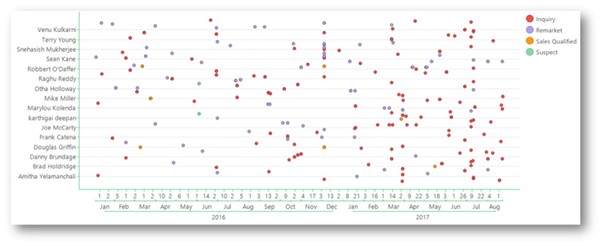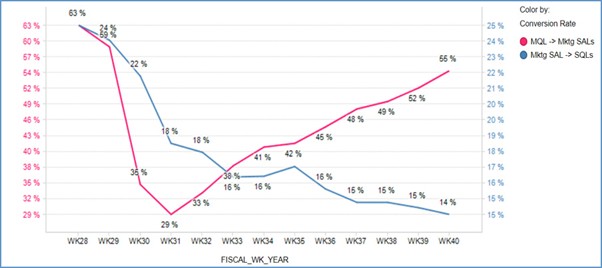As B2B marketers, we would like to think that marketing has since moved away from solely depending on traditional marketing tactics to performance marketing. The traditional marketing funnel typically covers five key stages of customer conversion—awareness, consideration, conversion, loyalty, and advocacy. These stages parallel customer lifecycle stages and sales—from acquisition through retention.
In this information age where digital trends like IoT, mobility, and collaboration open the floodgates to customer data, many organizations have already started investing in big data architecture to capture and collect it.
Typically, marketing and customer insight (CI) teams are then tasked to start segmenting the customer database based on an existing sales funnel, where most visibility is gained from active trading customers but does not necessarily provide a view where customer’s behavioural segments or lifetime value are considered.
Where marketing and sales used to delineate roles and responsibilities throughout a customers lifecycle, market intelligence and customer insights have helped to streamline and bring together both teams in the quest for better customer acquisition and retention.
The top of the funnel (ToFu) where awareness and consideration (acquisition) take place covers some of the first few customer touchpoints where both sales and marketing can collaborate for better results.
Pitching inside-out
The reality in this trend of delineation is that marketing first needs to convince sales in adopting the practices set up by the former when bringing customers through the funnel. To begin, we pinpoint some of the common themes that data can show which can start that discussion between sales and marketing.
i. Understanding interests
Tracking engagements through different touchpoints for identified accounts is a necessary step to kick off our alignment efforts. Looking at the example chart, we can find out when and how a customer has been engaging with the company, which can tell us a few things.
Through the chart, we can tell how often an identified prospect is getting in touch with the company when marketing tactics are in place when sales involvement starts, and how soon a customer becomes sales qualified.
The mapping of these engagements not only helps to put together a coherent view that is both useful for marketing and sales but also presents a timeline that can help us refine tactics to move customers down the funnel faster.
Now you may be thinking, “If only these dots on a graph can tell me HOW to move the customers, instead of just showing me these matter-of-fact facts!” This is where you would need to rely on your sales’ hunting instincts to tell you more than just “dots and lines.”
As marketers, we know how to adjust marketing and remarketing tactics so that it most effectively touches the customers when they want to (e.g., personalization). However, sales has the unique skills of knowing when a customer is genuinely interested, what to probe further into and to sense when to go in and seal the deal.
This knowledge and expertise can help us supplement data, so that we analyse the customer not just as a statistic, but as an individual — with probable likes and dislikes and for marketers to model a follow-up action plan with sales tactics already familiar with your hunting experts.

ii. Propensity to convert.
Diving deeper into the customer performance, we have to draw a week-by-week comparison of how quickly Marketing Qualified Leads convert to Marketing SAL and subsequently to Sales Qualified Leads.
With this view, there is no contest even as sales and marketing see how each is performing weekly. Where there is an uptrend alert in the MQL movement, marketing can look back at the first dashboard to tell them which marketing tactics had worked, if a tweak to the previous refinements had indeed improved the process, and sales can also derive several conclusions.
Sales can feedback to their marketing counterparts if their customers’ view aligns with how the trending analysis is showing.
At the same time, they can also use these inputs as a sounding board on the next stage of ensuring the speed of qualified leads through the funnel is keeping up with their revenue targets on a monthly, quarterly, or half-yearly basis.

Initiating the conversation
We’ve talked briefly about the different segmentation criteria that can help us pinpoint the best prospects.
At the initial stages, data segmentation based on understanding customer data (e.g., transactional-based) coupled with behavioural patterns analysis (channel of engagement, seasonality, brand loyalty) can further build a profile of relevancy for your sales conversation and also substantiate data points for your prospect scoring system.
These discussions to set a framework can help make your assumption more accurate, and therefore more dependable, for your decision-making processes down the line.
Another checkpoint to align sales and marketing collaboration is an agreement on a defined customer lifecycle roadmap, then using marketing analytics to determine if this is the most accurate customer experience from both perspectives.
This also reflects what Forrester noted as one of the key considerations when reviewing customer analytics vendors with the ability to “…Using techniques such as behavioural customer segmentation and customer look-alike targeting, [they] identify the right customers to deliver the right message to at the right time.”
Making the first impression
Time after time, we attest to the fact that customers do most of their research online and independently before even reaching out to a salesperson. Marketing thus can bring qualified leads to sales teams, using a methodical approach to target and retarget prospects before any sales engagement.
There is always room for refinement, especially around collective internal feedback on what kind of data works, which can be used and what is being used.
Besides asking what the marketing and sales work streams require, customer-facing workstreams such as customer service, operations, and finance management teams should be consulted to align available internal data sources and what additional data sources can be acquired for a holistic approach to data collection.
We’ve briefly mentioned above about using a definition to find “look-alikes” of your best prospect matches, and at the top of the funnel, your marketing teams can then enrich customer data by collecting information fitting identified data gaps within your organization.
Your sales teams can be armed, not only with an understanding of your prospects’ potential buying needs, but a real head-turning conversation starter can happen by pre-empting and understand the customer journey so far, right before the first call is dropped.
Different dashboards can be designed with sales and marketing to support the above. This is further enhanced for organizations with a CI or Customer Experience team involved.
For example, marketing can review current retargeting campaigns by running CI produced prospects scoring reports against matched cookies, giving you a richer customer profile to maximize targeted marketing efforts. This can be easily visualized and presented to digital teams or even external media partners.
Keep calm and pilot on
Aberdeen Research refers to data preparation as “any activity designed to improve the quality, usability, accessibility, or portability of data.” We may have all at some point experienced how poor data quality resulted in badly made business decisions. And this type of bad experience may have created an eagerness to focus on getting “perfect data quality” and in the process, be blindsided by the dynamic needs of users within your organization.
However, one of the best ways to get started while getting a quick turnaround and inputs on feasibility, a limited pilot can be introduced. This helps your organization both maintain sustainability in day-to-day business while exploring opportunities to scale up.
A limited pilot provides a platform to create and test a framework where value can be proven early on, and success measurements can be set in place. Refinements can be made along the way, and ideally, a workgroup with involvement from key stakeholders should be established to gain commitment from the ground.
On a practical note, change management can also be better handled when risks can be assessed and mitigated. In our next article, we’ll move down the funnel and review the various checkpoints where analytics can support and direct sales follow-up, while continuously feeding inputs around opportunities and growth accelerators.





